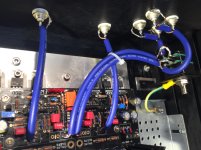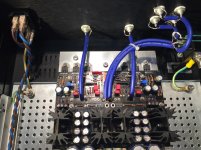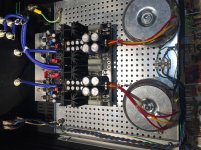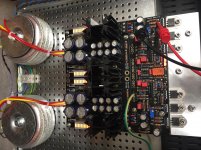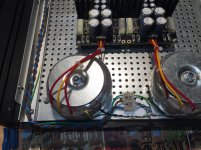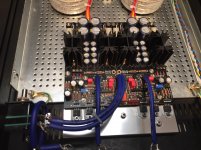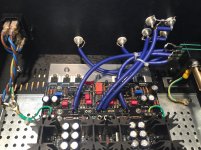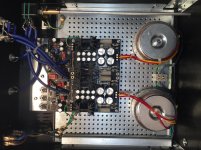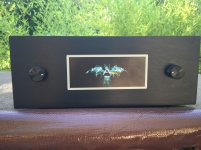Hi, DCSTB is clean, even, and efficient with DCG3, if you want to keep it that neutral use a good switcher pot, if going after a more organic result put a TKD 2CP-2511 20K Log. Also use BC327-40 for Q1 Q2. By the way, DCSTB is already dual mono as it comes.
If you go dual mono shunts its a much more heated solution demanding good sinking and chassis floor real estate too, usually brings even more impressive bass and upper bass resolve in this but it also may come across heavy in some systems. If so happens it may push you to resort in passive parts tonal offset tuning experiments on the shunts. Electrolytics mainly.
All in all a much more involved and bit experimental down to taste affair.
Hello Salas,
is this TKD pot you're suggesting?
seems like a shunt type.
TKD 2CP-2500 Series Potentiometer | Hifi Collective
There is also a new one 2CP-601S. I think this type is directly solderable to your I-select board?
TKD 2CP-601/S Potentiometer | Hifi Collective
Last edited:
Hi Salas,
thanks allot for guidance - sounds terrific. Will you expect tonal changees when
using a 50klog pot? And how is the difference soundwise compared to your tube
linepreamp?
As i understand the DCSTB is dual Mono, as is the DCG3 PCB. So GND is connected
at the input-board? Wouldn´t is be better to go dual-mono at the input-board too?
Greetings
thanks allot for guidance - sounds terrific. Will you expect tonal changees when
using a 50klog pot? And how is the difference soundwise compared to your tube
linepreamp?
As i understand the DCSTB is dual Mono, as is the DCG3 PCB. So GND is connected
at the input-board? Wouldn´t is be better to go dual-mono at the input-board too?
Greetings
@le 'flu
With 50K pot it sounds bit slower and sweeter. Its a matter of going for synergy with sources and mainly loudspeakers. VS the 6V6 line preamp its more revealing and open wide, has more drive in the bass also, less noise, but not tonally aggressive like some older typical solid state. Does not have the triode tinge of course but it meets higher neutrality criteria. Its generally ample sounding, no manifestations of a small hyper organized cold caricature sound. There is naturally expanded midrange and bass slam not boom.
Yes GND will be connected to the relays input board. You could go dual mono switch boards but its a complex enough thing to do. Nobody had problems with normal switch boards though. Using a classic good quality rotary switch with extension rod isn't out of the question also.
With 50K pot it sounds bit slower and sweeter. Its a matter of going for synergy with sources and mainly loudspeakers. VS the 6V6 line preamp its more revealing and open wide, has more drive in the bass also, less noise, but not tonally aggressive like some older typical solid state. Does not have the triode tinge of course but it meets higher neutrality criteria. Its generally ample sounding, no manifestations of a small hyper organized cold caricature sound. There is naturally expanded midrange and bass slam not boom.
Yes GND will be connected to the relays input board. You could go dual mono switch boards but its a complex enough thing to do. Nobody had problems with normal switch boards though. Using a classic good quality rotary switch with extension rod isn't out of the question also.
Hi Salas,
I have completed all the tests, results as follows.
Right R10 1.2V.
Left R10 1.1V, both with 10-ohm resistors.
Rails.
Left negative 17.45, positive 17.41.
Right negative 17.29, positive17.32.
Mosfets 40/42°
Sink below mosfets 38/39°.
Inner PSU sinks 49/51°.
Outer PSU sinks 45/46° and 47/48°.
Without the opamp + or- 5MV.
With the opamp one side stayed pretty much around 0 whilst the other side had occasional trips up and down to around + or - 2/3mv.
I have ground continuity to all metal parts, at the moment I do not have ground connected to the DCG3 boards and would like to know if it is OK to use the HP G as I am not using them for anything, should I bridged one to the other and then go to the mains earth or one to mains and one to the pot earth?
This is my first time wiring up a pot and would appreciate a quick check over.
Line out to pin 1, pin 2 to RCA and both grounds are to pin C.
As you can see in the photos I'm just using one input but may add the I select at a later date if required.
I have bridged across for my 2 outputs.
If you could have a general visual check over that would be great and if all is well I'll connect up the PCB earth and give it a whirl.
I have completed all the tests, results as follows.
Right R10 1.2V.
Left R10 1.1V, both with 10-ohm resistors.
Rails.
Left negative 17.45, positive 17.41.
Right negative 17.29, positive17.32.
Mosfets 40/42°
Sink below mosfets 38/39°.
Inner PSU sinks 49/51°.
Outer PSU sinks 45/46° and 47/48°.
Without the opamp + or- 5MV.
With the opamp one side stayed pretty much around 0 whilst the other side had occasional trips up and down to around + or - 2/3mv.
I have ground continuity to all metal parts, at the moment I do not have ground connected to the DCG3 boards and would like to know if it is OK to use the HP G as I am not using them for anything, should I bridged one to the other and then go to the mains earth or one to mains and one to the pot earth?
This is my first time wiring up a pot and would appreciate a quick check over.
Line out to pin 1, pin 2 to RCA and both grounds are to pin C.
As you can see in the photos I'm just using one input but may add the I select at a later date if required.
I have bridged across for my 2 outputs.
If you could have a general visual check over that would be great and if all is well I'll connect up the PCB earth and give it a whirl.
Attachments
Thanks.
It stops just at the edge of the PCB, was struggling to find one solid piece of ally bar so it's 4 pieces of 35mm x 3mm X160mm all bolted together with heatsink gloop in-between, I wasn't sure how it was going to fit with the support tray but it went in very nicely and is over the vents for cooling.
It stops just at the edge of the PCB, was struggling to find one solid piece of ally bar so it's 4 pieces of 35mm x 3mm X160mm all bolted together with heatsink gloop in-between, I wasn't sure how it was going to fit with the support tray but it went in very nicely and is over the vents for cooling.
Why you wired the volume pot at the output? Volume pot should go between Line in RCA and Line in PCB.
You should move the blue coaxial cables to the correct PCB places for exchanging their now in/out routes.
RCA in hot-->cable-->pot pin 1, pin 2-->cable--> line in PCB. Cable shield RCA cold to C to PCB line in G.
For PCB to chassis ground reference wire see post #4761.
Mechanically its a very good tight build, congratulations.
What was the room ambient temperature when you measured the Mosfets and sinks?
How you did that? With a non contact infrared meter or with a thermocouple probe?
You should move the blue coaxial cables to the correct PCB places for exchanging their now in/out routes.
RCA in hot-->cable-->pot pin 1, pin 2-->cable--> line in PCB. Cable shield RCA cold to C to PCB line in G.
For PCB to chassis ground reference wire see post #4761.
Mechanically its a very good tight build, congratulations.
What was the room ambient temperature when you measured the Mosfets and sinks?
How you did that? With a non contact infrared meter or with a thermocouple probe?
I don't know the exact room temperature but it will have been quite high as my workshop is outside and Provence has started to get quite hot.
I used a non-contact infrared meter for all the temperature testing.
I'll make the wiring changes and get back ASAP.
Those conditions might explain the rather elevated temperature readings. If the infrared meter has emissivity adjustment its a very useful feature.
https://thermometer.co.uk/img/documents/emissivity_table.pdf
A layman question, I have my DCG3 currently running with +/-17vdc (as per the schematics) from Salas 1.1 psu boards. Instead can I use a +/-15vdc for DCG3 if I am going to use this purely from a headphone amp perspective? I have a Silent Switcher which can provide a constant 15vdc at around max of I think 200mA via a simple mobile charger. If yes do I need to change any components or biasing from the standard?
Thanks
Thanks
It runs at +/-15V also. Current bias will not be affected. In case the relay will not respond due to limited voltage just replace one of the three LEDs with a jumper. Because those drop the voltage from a usual 17V to the 12V relay. Relays normally have a lower must turn on threshold though and still work over a wide range around their nominal.
It runs at +/-15V also. Current bias will not be affected. In case the relay will not respond due to limited voltage just replace one of the three LEDs with a jumper. Because those drop the voltage from a usual 17V to the 12V relay. Relays normally have a lower must turn on threshold though and still work over a wide range around their nominal.
Thanks Salas, I will try with +/-15vdc and see if it works or else will do as you say.
I re-tested the temperatures this morning, with an ambient 22/23° in the workshop (unlike the oven it becomes after 4pm).
Mosfets 36/37°
Sink below mosfets 31/33°
Inner PSU sinks 42/43°
Outer PSU sinks 40/41°
The above was with the lid off, after placing the lid on for around 10 mins the mosfets remained at the same temperature whilst all the sinks went up by about 3or4°.
As you can see in the photo I have changed the pot wiring (apologies for that clanger) and added two grounds from the board to mains star ground.
I think I'm good to go.
Mosfets 36/37°
Sink below mosfets 31/33°
Inner PSU sinks 42/43°
Outer PSU sinks 40/41°
The above was with the lid off, after placing the lid on for around 10 mins the mosfets remained at the same temperature whilst all the sinks went up by about 3or4°.
As you can see in the photo I have changed the pot wiring (apologies for that clanger) and added two grounds from the board to mains star ground.
I think I'm good to go.
Attachments
Some fighter jets during the cold war carried mock missiles to intimidate foes until better armed in the future so your mock knob sin is relatively innocent. 
Not sure if you need the second ground to chassis reference wire, but if the build will behave quietly in audition, just leave it there. If there will be hum remove the left side wire completely and secure the right side one to the nearby pot body's referencing chassis lug.
Not sure if you need the second ground to chassis reference wire, but if the build will behave quietly in audition, just leave it there. If there will be hum remove the left side wire completely and secure the right side one to the nearby pot body's referencing chassis lug.
I attached one ground wire (nearest one to mains ground first) and that had continuity to ground but upon probing the other side I found no continuity there, hence the second wire.
If all is silent then I'll probably leave well alone.
I believe the odd dictator has marched his army around the block several times in order to appear much larger for the onlooking cameras, my sins feel quite tiny in comparison
If all is silent then I'll probably leave well alone.
I believe the odd dictator has marched his army around the block several times in order to appear much larger for the onlooking cameras, my sins feel quite tiny in comparison
I have 18 Reel 2 Reel players of which the best one is my Studer A810 my hobby is restoring and recalibrating R2R
Alan
Hi Alan, I chanced on this video today, I believe its yours. A superb machine indeed.
Studer A810
- Home
- Source & Line
- Analog Line Level
- Salas DCG3 preamp (line & headphone)
